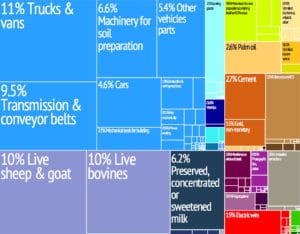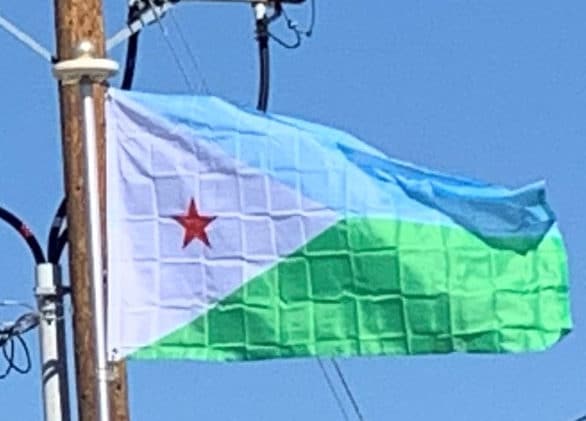Most of Djibouti is part of the Ethiopian xeric grasslands and shrublands ecoregion. The exception is an eastern strip located along the Red Sea coast, which is part of the Eritrean coastal desert.
Economy:
Djibouti’s economy is largely concentrated in the service sector. Commercial activities revolve around the country’s free trade policies and strategic location as a Red Sea transit point. Due to limited rainfall, vegetables and fruits are the principal production crops, and other food items require importation. Per capita income is around $2,874 (PPP). The services sector constituted around 79.7% of the GDP, followed by industry at 17.3%, and agriculture at 3%.
As of 2013, the container terminal at the Port of Djibouti handles the bulk of the nation’s trade. About 70% of the seaport’s activity consists of imports to and exports from neighboring Ethiopia, which depends on the harbor as its main maritime outlet. As of 2018, 95% of Ethiopian transit cargo was handled by the Port of Djibouti. The port also serves as an international refueling center and transshipment hub. In 2012, the Djiboutian government in collaboration with DP World started construction of the Doraleh Container Terminal, a third major seaport intended to further develop the national transit capacity. A $396 million project, it has the capacity to accommodate 1.5 million twenty foot container units annually.
Additionally, efforts have been made to lower the estimated 60% urban unemployment rate by creating more job opportunities through investment in diversified sectors. Funds have especially gone toward building telecommunications infrastructure and increasing disposable income by supporting small businesses. Owing to its growth potential, the fishing and agro-processing sector, which represents around 15% of GDP, has also enjoyed rising investment since 2008.

To expand the modest industrial sector, a 56 megawatt geothermal power plant slated to be completed by 2018 is being constructed with the help of OPEC, the World Bank and the Global Environmental Facility. The facility is expected to solve the recurring electricity shortages, decrease the nation’s reliance on Ethiopia for energy, reduce costly oil imports for diesel-generated electricity, and thereby buttress the GDP and lower debt.
The Djibouti firm Salt Investment (SIS) began a large-scale operation to industrialize the plentiful salt in Djibouti’s Lake Assal region. Operating at an annual capacity of 4 million tons, the desalination project has lifted export revenues, created more job opportunities, and provided more fresh water for the area’s residents. In 2012, the Djibouti government also enlisted the services of the China Harbor Engineering Company Ltd for the construction of an ore terminal. Worth $64 million, the project is scheduled to be completed within two years and will enable Djibouti to export a further 5,000 tons of salt per year to markets in Southeast Asia.
The Djiboutian franc is the currency of Djibouti. It is issued by the Central Bank of Djibouti, the country’s monetary authority. Since the Djiboutian franc is pegged to the U.S. dollar, it is generally stable and inflation is not a problem. This has contributed to the growing interest in investment in the country.
Transportation:
The Djibouti–Ambouli International Airport in Djibouti City, the country’s only international airport, serves many intercontinental routes with scheduled and chartered flights. Air Djibouti is the flag carrier of Djibouti and is the country’s largest airline.
